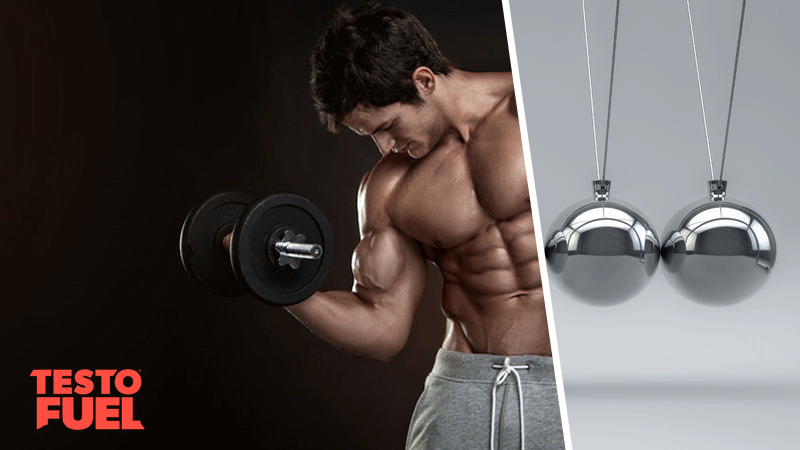TestoFuel Blog : Make Gains & Pack on the Muscle

Testosterone and testicular size are closely related.
During the onset of puberty, both testes size and testosterone levels increase at a fast rate. It’s testosterone that transforms you from a child to a broad-shouldered, strong and assertive man.
Hormones control everything from your libido and sex drive to your muscle mass, athleticism and stamina. They even control your health and well-being too.
One of the biggest concerns for men with low testosterone is testicular size – after all, what man wants have smaller than average sized balls?
In this article we take a look at the connection between hormones and testes size.
Read on to find out more…
Testicle volume is an important predictor of male reproductive function. This is because the size of your balls is directly correlated to the amount and quality of your semen [1].
The seminiferous tubules that are responsible for producing, maturing and transporting sperm, take up most space in the testes, meaning larger gonads is simply better for reproduction.
The biggest change in testicular size occurs during puberty, when your testes develop and double in size.
From the age of 10 onward, various parts of your reproductive anatomy grow in size, including enlargement of seminiferous tubules, seminal vesicles, prostate and epididymis.
It’s no coincidence that during puberty there is also a huge increase in testosterone levels too.
As a kid, your precocious (pre-puberty) hormone levels are as low as 11-30 ng.dL whereas in a fully grown adult, normal testosterone is indicated by levels of 300-1,000 ng.dL.
So could testosterone and testicular size by related?
And could low hormone levels spell disaster for your balls?
Let’s take a look at the research…
Not all men are built the same.
Different heights, weights, muscle volumes and body fat levels make you who you are.
But one of the lesser talked about differences is in testes size. Even in the scientific research you’ll find numerous animal studies on the reproductive system – but when it comes to humans, surprisingly there are aren’t many studies to draw upon.
Here’s what the few studies do tell us though:
One interesting study found that when 2,700 men were assessed in the name of science, there were a number of variables that affected gonad size.
These included:
Being taller meant larger testicles, but both low body weight and exposure to high temperatures meant smaller ones. Interestingly, men who lived in rural areas were 1.6 time more at risk of having low testicular volume too, although the possible cause of this wasn’t explained.
This could be down to high temperature exposure, but may also be due to chemicals that can also lower T levels.
The study basically pointed out that both genetics and environmental factors were important in influencing the size of testes in men.
Your reproductive system has the amazing ability to regulate internal temperature.
Gonads like to operate at temperatures between 2-4 degrees Celsius below your normal body temperature.
If it’s cold, your body uses its cremasteric reflex to pull your testicles into your abdomen. At higher temperatures they hang lower to cool down.
The problem is though that when exposed to excessively high temperatures for long periods of time, they may actually shrink if they can’t find a way of normalizing heat control.
That’s right; heat can make your testicles shrink.
For example, a study published in the Archives of Andrology [2] found that when exposed to temperatures of 43 °C (109 °F) for as little as 15 minutes, testicular weight reduced by as much a 65%.
Granted, the study was in rats… but it’s still an important finding nonetheless.
Even in men, sitting for long periods of time can lead to high gonad temperatures. And this can progress to a drop in sperm count by up to 40% per 1 degree Celsius increment [3].
Key Point: The size of your testes can be influenced by both genetics and environmental factors.
Other than an extremely small amount, all of the testosterone in your body right now was produced in your testes.
The whole of your reproductive system is inter-related. For example, optimal testosterone levels means increased sperm counts, better fertility, healthier Leydig cell numbers and circulating androgen precursor hormones [4].
It’s no surprise then that testosterone and testicular size should be so closely related too.
Some men suffer from genetic disadvantages. Even limited exposure to male hormones during masculinity development while in the womb can effect circulating testosterone in adulthood.
Remember, sperm production is proportional to testicular size. And its quality is also directly related to testosterone levels.
Genetics, disease (such as Kallmann syndrome) and even hypogonadism – clinically low testosterone levels – have all been found to elevate the risk of smaller testes in men [5].
Although the use of anabolic steroids is still popular among bodybuilders and athletes, some forms of the drug can have severe consequences when it comes to the male reproductive system.
Published in the Journal of Urology [5], one study found that regular use of the drug testosterone enanthate (the most common steroid of all time) led to a reduction in testicular size by 23%.
In the study, short-term drug use had no real detrimental effect.
But as soon as the regular injections of less than 5 ml went past the 16 week mark, testes size reduced – and sperm count decreased to less than 5 million per cc.
While smaller gonads doesn’t necessarily mean you can’t have children, it’s a possibility and something you should bare in mind – particularly if you have lower T levels as well.
Smaller testes size often indicates poor overall health.
If you drink too much, don’t get enough exercise, smoke or don’t eat healthily you might be at a higher risk of male infertility.
Key Point: Smaller testicles may increase the risk of infertility, particularly when combined with low testosterone levels.
When it comes to testosterone and testicular size, the two are related.
Although the relationship isn’t set in stone, both low testosterone and testicular volume can affect sperm production and fertility.
